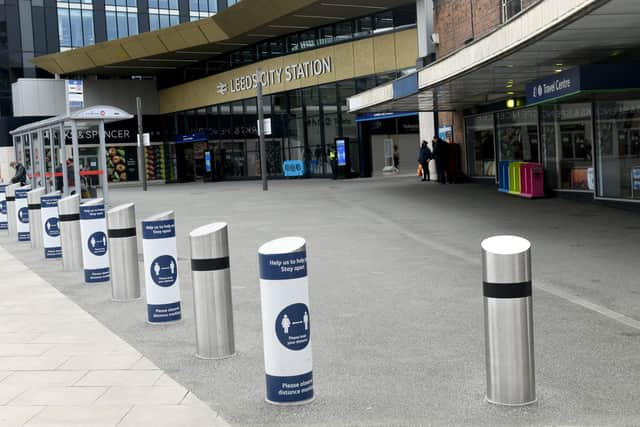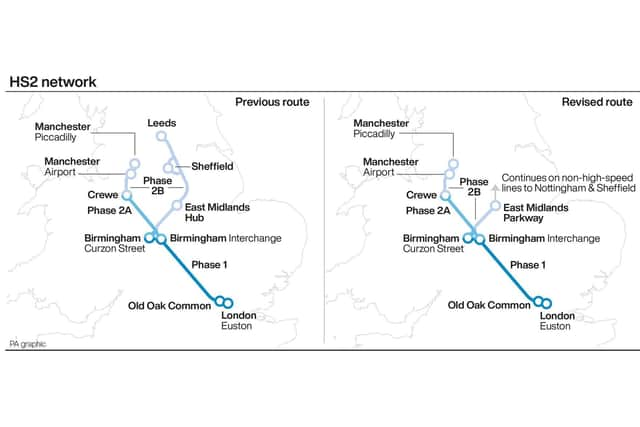Transport in Leeds: A history of HS2 and city's doomed mass transit plans such as Supertram
and live on Freeview channel 276
HS2 in Leeds
HS2, a high-speed rail, was planned to be extended from Birmingham to Leeds.
However, the Government confirmed today that the planned extension of HS2 from the East Midlands to Leeds has been scrapped.


Advertisement
Hide AdAdvertisement
Hide AdPrime Minister Boris Johnson confirmed that as part of the Integrated Rail Plan, the HS2 link to Leeds is being dropped with a “new study” ordered on the best way to eventually get the city connected to the network.
Mr Johnson said: “HS2 will come to Sheffield, meaning a trip to or from London will take just one hour 27 minutes – precisely the same as under the old HS2 plans. We’ll look at how to get HS2 to Leeds too, with a new study on the best way to make it happen.”
The Prime Minister said “long stretches of brand new high-speed track” will be part of the Northern Powerhouse Rail (NPR) project to reduce journey times between Leeds and Manchester.
He also insisted the Integrated Rail Plan (IRP) would double capacity between Manchester and Leeds and treble that between Manchester and Liverpool.


Advertisement
Hide AdAdvertisement
Hide AdHowever, he made no mention of including Bradford directly on an entirely new NPR route between Leeds and Manchester, as northern leaders have been calling for. But he said route upgrades between Leeds and Bradford will take place “by the early 2030s” to halve journey times, while committing to NPR reaching York.
Louise Gittins, interim chairwoman of Transport for the North, described the announcement as “woefully inadequate”.
West Yorkshire mayor Tracy Brabin told a press conference the rail plan was a “betrayal of the North” and a “betrayal of the Government’s levelling-up promise”.
The Labour mayor said it was a “20th century upgrade to 19th century infrastructure” rather than the promised new lines.
Advertisement
Hide AdAdvertisement
Hide AdShe said the plan “doesn’t deliver HS2 in full to Leeds, it doesn’t deliver a high-speed line across the Pennines with that crucial city stop in Bradford, it does not support our ambition as northern leaders for a stronger, fairer and better-connected North for all”.
“Whitehall seems not to have listened to northern voices. HS2 will now stop short of Yorkshire and the high-speed Northern Powerhouse Rail will stop at the border. This is not levelling up.”
Leeds central MP Hilary Benn added: "This is a betrayal and the Prime Minister has broken his word.
"He repeatedly promised that the HS2 would come to Leeds.
"He repeatedly promised we would see Northern powerhouse rail in full and it looks as though neither is going to happen."
What about a mass transit system, such as a tram?
Advertisement
Hide AdAdvertisement
Hide AdLeeds is now the largest city in Western Europe without a built-in mass transit system, such as a tram or underground rail.
But why has Leeds struggled so badly to build one?
Electric trams in the city date back to the early 1900s, before services were abandoned in the 1950s due mainly to the rise in suburban living and the personal car.
But since then, numerous attempts have been made to get the people of Leeds back on public transport.
The city proposed a “bus rapid transit” network in the late 1960s, which would have acted as a network of express buses, as well as early form of “park and ride” scheme in Kirkstall Road.
Advertisement
Hide AdAdvertisement
Hide AdThe services would have connected Leeds City Centre with Bradford, Wakefield, Pudsey, Alwoodley, as well as parts of east and south Leeds.
Unfortunately, it wasn’t enough to coax commuters from their cars. And services would ultimately be cancelled.
Inspired by London’s Docklands Light Railway scheme, which opened that year, the council came up with plans for the east Leeds light railway service dubbed the “metro line” in 1987.
The plans included connecting Leeds Town Hall, the Headrow and Quarry Hill with areas of east Leeds, such as Killingbeck, Halton, Colton and Seacroft.
Advertisement
Hide AdAdvertisement
Hide AdBut the scheme met with strong objection from some living in new houses in Colton – who said the line would travel too close to their houses. The scheme was dropped during public consultation.
A larger mass transit idea emerged in the 1990s – known as Supertram. This would see three lines – Headingley, East Leeds and South Leeds, with four terminals – Bodington, Grimes Dyke, Stourton and Tingley.
Funding for the scheme was approved by Government in 2001, but increasing costs saw the scheme shelved three years later, and finally scrapped by central Government in 2005.
In 2012, government ministers gave the green light to a £250m electric trolleybus scheme.
Advertisement
Hide AdAdvertisement
Hide AdIt was hoped that, by 2018, electric buses powered by overhead wires would be running across the city on a north/south route every six minutes during peak times.
But this was scrapped four years later when transport minister Lord Ahmad accepted a planning inspector’s recommendation the scheme should not go ahead.
More than £70m had been spent on the trolleybus scheme and its predecessor Supertram.
Earlier this year, West Yorkshire Combined Authority (WYCA) released preliminary plans to create a rail-based mass transit network – possibly a tram system – to cover the whole of West Yorkshire.
Advertisement
Hide AdAdvertisement
Hide AdThe Intra-city Transport Fund is a £4.2bn government scheme, which will be split between eight mayoral authorities.
The embryonic mass transit plans suggest such a system could include nine lines and dozens of stops, including Leeds Bradford Airport, Leeds General Infirmary, St James’s Hospital, Elland Road and the White Rose Centre.
Unlike previous proposals, the scheme covers the whole of the region, stretching to Huddersfield, Halifax, Pontefract, Bradford and Wakefield.
WYCA believes construction could start on lines as early as 2025, with priority given to those in and around Leeds. If all goes to plan, the final scheme could be completed at early as 2040.
Advertisement
Hide AdAdvertisement
Hide AdIn today's Integrated Rail Plan announcement, Mr Johnson committed to the creation of a metro system for Leeds and the surrounding area which will be known as West Yorkshire Mass Transit.
He defended the decision to scrap previous plans. “Under the original blueprint, first drawn up more than a decade ago, Yorkshire would have not have seen the benefits of our investment until at least the 2040s,” he said.
He added: “If we are to see levelling up in action now, we must rapidly transform the services that matter to people most.
“That’s why the Integrated Rail Plan will be the biggest transport investment programme in a century, delivering meaningful transport connections for more passengers across the country, more quickly – with both high-speed journeys and better local services, it will ensure no town or city is left behind.”.
